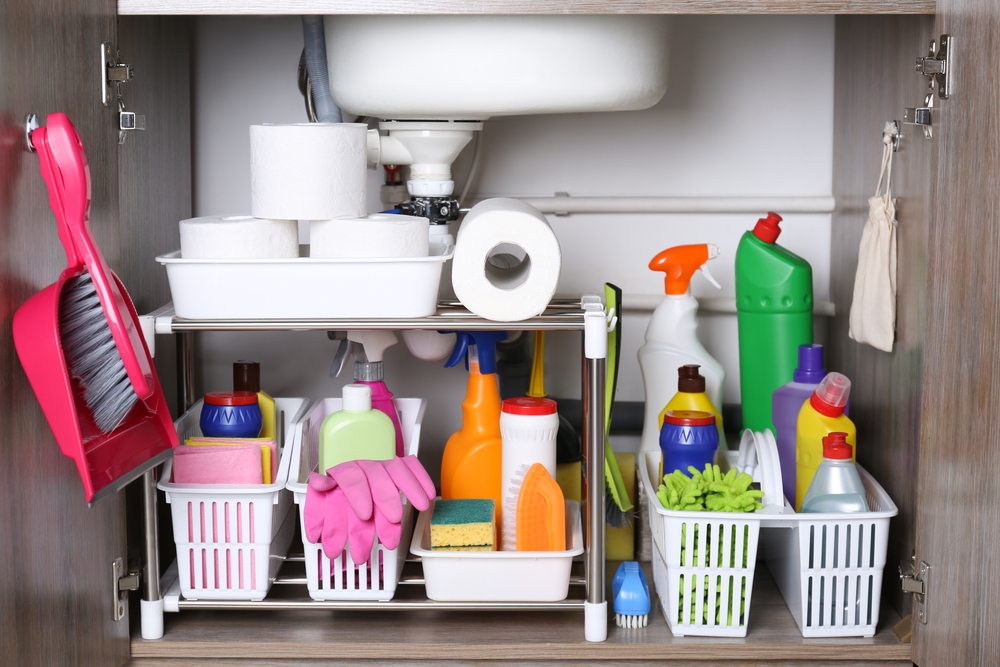Transform your chaotic under-sink cabinet into an organized cleaning command center with our expert guide. Learn proven strategies for sorting, storing, and maintaining your cleaning supplies efficiently.
The Hidden Chaos Under Your Sink
We’ve all been there: reaching under the sink for a cleaning spray, only to knock over three bottles, bump into a leaking pipe, and still not find what we need. The average American household contains 45 different cleaning products, and most end up crammed into that mysterious space under the kitchen sink. But it doesn’t have to be this way.
In this comprehensive guide, you’ll discover:
- Professional organization techniques that maximize every inch of space
- Smart storage solutions that prevent costly product waste
- Safety measures to protect your family and home
- Maintenance systems that keep chaos at bay
Time investment: 15-minute read, lifetime organization benefits Difficulty level: Moderate Cost: $20-100 depending on chosen solutions
Why Under-Sink Organization Matters
Beyond the frustration of searching for supplies, proper under-sink organization impacts several aspects of your daily life:
Safety First
Cleaning products contain chemicals that can be hazardous if mixed or improperly stored. Organized storage prevents accidental spills and dangerous combinations. According to the National Safety Council, 84% of accidental household poisonings involve cleaning products – proper organization dramatically reduces this risk.
Financial Benefits
- Prevent duplicate purchases
- Extend product life through proper storage
- Avoid damage from leaks
- Track expiration dates efficiently
Environmental Impact
Organized storage helps you:
- Use products completely before replacing
- Identify eco-friendly alternatives
- Maintain refillable containers
- Reduce waste through proper inventory management
Before You Start: Assessment Phase
Essential Supply Inventory Checklist
Before diving in, document everything currently stored under your sink:
□ All-purpose cleaners □ Specialized cleaning products □ Sponges and scrubbers □ Gloves and protective gear □ Paper towels and cloths □ Trash bags □ Plumbing supplies
Safety Inspection
- Check for pipe leaks
- Identify proper ventilation
- Assess electrical outlets
- Note cabinet condition
Space Planning
Measure your cabinet dimensions:
- Width
- Height
- Depth
- Pipe clearance
- Door swing radius
Step-by-Step Organization Process
1. Empty and Clean
Start with a blank slate by removing everything from under your sink. This is your opportunity to:
Deep Clean the Cabinet
- Vacuum debris
- Wipe surfaces with disinfectant
- Allow to dry completely
- Apply shelf liner (optional but recommended)
Inspect for Issues
- Water damage signs
- Mold presence
- Cabinet floor integrity
- Pipe condition
Pro tip: Take a “before” photo for motivation and comparison.
2. Sort and Declutter
Create three categories:
- Keep: Items used regularly and in good condition
- Dispose: Expired or damaged products
- Relocate: Items better stored elsewhere
Hazardous Material Guidelines
- Check expiration dates
- Ensure proper seals
- Identify dangerous combinations
- Document disposal requirements
3. Smart Storage Solutions
Essential Organization Products
- Pull-out Drawers ($20-40)
- Perfect for deep cabinets
- Easy access to back items
- Available in various sizes
- Tension Rods ($8-15)
- Utilize vertical space
- Hang spray bottles
- Adjustable positioning
- Turntables ($15-25)
- Ideal for corner access
- Multiple height options
- 360-degree rotation
- Clear Bins ($5-15 each)
- Category separation
- Stack efficiently
- Visual inventory management
DIY Solutions
- Repurposed shower caddies
- Command hooks for tools
- PVC pipe organizers
- Magazine holders for supplies
4. Strategic Placement
Organize items based on:
Frequency of Use
- Daily items at front
- Weekly items middle
- Monthly items back
Safety Considerations
- Separate chemicals
- Childproof locks
- Leak protection trays
- Proper ventilation
Maintenance and Upkeep
Monthly Maintenance Checklist
□ Inventory check □ Expiration date review □ Leak inspection □ Quick reorganization □ Restock essentials
Daily Reset
- Return items to designated spots
- Wipe spills immediately
- Check for leaks
- Close containers properly
Special Considerations
Small Space Solutions
- Use door-mounted organizers
- Maximize vertical space
- Choose concentrated products
- Implement modular systems
Large Family Adaptations
- Color-code by user
- Create cleaning kits
- Implement labeling system
- Establish access rules
Professional Tips and Tricks
Expert Insights
- “Store items in clear containers for easy identification” – Marie Kondo
- “Group similar items together” – The Home Edit
- “Use drawer liners to protect against leaks” – Martha Stewart
Common Mistakes to Avoid
- Overcrowding
- Ignoring vertical space
- Skipping labels
- Mixed chemical storage
Sustainable Organization Practices
Create an eco-friendly under-sink system:
- Install refill stations
- Use glass containers
- Choose concentrated products
- Implement recycling systems
Troubleshooting Common Issues
Leak Management
- Install water detection sensors
- Use waterproof bins
- Regular pipe maintenance
- Quick response protocol
Humidity Control
- Add moisture absorbers
- Improve ventilation
- Regular monitoring
- Protective barriers
Measuring Success
Organization Metrics
□ Reduced cleaning time □ Lower product waste □ Improved accessibility □ Maintained organization
Conclusion
A well-organized under-sink area transforms your cleaning routine from chaos to efficiency. By implementing these strategies, you’ll save time, money, and stress while maintaining a safer home environment.
Take Action Now:
- Schedule your organization day
- Gather supplies
- Follow our step-by-step guide
- Maintain your new system
Frequently Asked Questions
Q: How often should I reorganize under-sink supplies? A: Conduct a full reorganization quarterly, with monthly maintenance checks.
Q: What shouldn’t be stored under the sink? A: Avoid storing food items, electronics, or items sensitive to moisture and temperature changes.
Q: How do I maximize deep cabinet space? A: Use pull-out drawers and tiered organizers to utilize the full depth of the cabinet.
Q: What are the best containers for under-sink storage? A: Clear, stackable containers with secure lids work best. Choose waterproof options with good ventilation.


